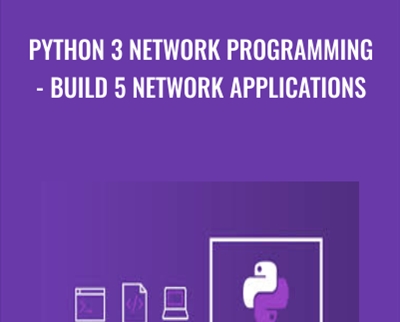Buy Python 3 Network Programming-Build 5 Network Applications – Mihai Catalin Teodosiu Course at GBesy. We actively participate in Groupbuys and are committed to sharing knowledge with a wider audience. Rest assured, the quality of our courses matches that of the original sale page. If you prefer, you can also buy directly from the sale page at the full price (the SALEPAGE link is directly provided in the post).
Salepage link: At HERE. Archive:
$49 $20 – Python 3 Network Programming-Build 5 Network Applications – Mihai Catalin Teodosiu
? Why would you take this course?
Hi! My name is Mihai. I’ve been a Network Engineer since 2008, having the privilege of working for 3 major corporations and configuring, maintaining and testing multi-vendor network environments. At the same time, I managed to obtain several well-known certifications, such as CCNA, CCDA, JNCIA and CCNP, which complemented the skills I was getting from my job and increased the number of job offers I was receiving to my LinkedIn inbox.
But the thing that simply jumpstarted my career was learning the Python programming language and implementing it in some of my daily tasks and processes. I’ve been a self-taught guy for most of my adult life and, since I lacked the time to read endless, boring programming books, I chose to learn by watching video tutorials and “getting my hands dirty” with code. Unfortunately, at that time I was unable to find a complete, coherent programming course for network engineers, so I had to put together various pieces of information scattered across Google and YouTube.
Almost two years later, after I had the chance to practice my new Python skills intensively, performing various tasks on network devices and automating hundreds of network tests, I decided to create this course for you – the network professional who knows that getting a certification just isn’t enough anymore in today’s job market. The ability to write scripts and automate certain tasks is one of the primary skills that the big employers are looking for.
This course simply enables you to save time and efforts whilst acquiring these in-demand skills and upgrading your career.
Join thousands of successful network engineers who have decided to learn Python using this 100% hands-on course!
Without further ado, I’ll let you read more about the contents of the course down below and I’ll hopefully see you in the first lecture.
- 10+ Hours of Python 3 Content Designed for Network Engineers
- Full Python Apps, Notebooks and Cheat Sheets are included
- Free Python 3 Syntax E-book Included
- GNS3 Academy Bestselling Instructor
- 70.000+ Satisfied Students Across Several E-learning Platforms
“Have finished 35% of the course, so far it’s the best Python-for-network-engineer course I have ever attended, fundamental topics are well demonstrated and explained, I strongly recommend this course to any network engineers who want to master Python in a relatively short period of time.” by Parry Wang
? What others have to say about my Python courses?
Before you read what I have to say, see what my students are saying about my courses:
“What an incredible value and learning experience!” by Sean A.
“Excellent material. Kudos to a great instructor with a vast level of creativity.” by Anthony W.
“I can say this man is going on smoothly and perfectly, explaining in the most empirical/foundational way.” by Kolapo A.
? What’s this course all about?
Python Network Programming (version 3.7) course aimed not only at network professionals, but at anyone having little or no experience in coding or network automation and a great desire to start learning Python from scratch. This hands-on Python Network Programming training takes you from “Hello World!” to building complex network applications in no time.
During this course you will learn Python concepts which are relevant to your networking job and build some amazing network tools:
- Python 3 – Basics
- Python 3 – Strings
- Python 3 – Numbers and Booleans
- Python 3 – Lists
- Python 3 – Sets
- Python 3 – Tuples
- Python 3 – Ranges
- Python 3 – Dictionaries
- Python 3 – Conditionals, Loops and Exceptions
- Python 3 – Functions and Modules
- Python 3 – File Operations
- Python 3 – Regular Expressions
- Python 3 – Classes and Objects
- Python 3 – Advanced Concepts and Tools
- Python 3 – Download the Python 3 Cheat Sheet
- Python 3 – Download the Python 3 E-Book
- Setting Up the Working Environment
- Network Application #1 – Reading / Writing Device Configuration via SSH
- Network Application #2 – Building an Interactive Subnet Calculator
- Network Application #3 – Extracting Network Parameters & Building Graphs
- Network Application #4 – Building a Basic Network Packet Sniffer
- Network Application #5 – Config File Management and E-mail Notifications
- [BONUS] Running Python Code via Remote Servers
- Final Section
Sounds unbelievable given your current programming experience? Well, it’s true! How?
First, you will learn and practice every Python 3 key concept, which is explained in one or more video lectures, followed by a short quiz. Each video is filled with relevant examples, in a learn-by-doing fashion and the quizzes will help you consolidate the main ideas behind each Python topic.
After laying the foundation (and also exploring some advanced Python topics), you will dive right into the real-life network scenarios and apply your knowledge to build 5 great network tools using the power of Python.
Equipped with working files, cheat sheets and Python code samples, you will be able to work alongside me on each lecture and each application. I will provide a virtual machine with all the Python modules already installed and also the full code for each application, so you can save time and start coding and testing on the spot.
We will use emulated Arista vEOS switches in VirtualBox to test our Python apps in a network environment, so you can see the actual results of running your Python code.
I encourage you to learn Python, an amazingly beginner-friendly programming language and take your network engineering job to a higher level of automation.
? What others have to say about this course?
“I have been programming since 1978 and wanted to learn python. I have had no java or OOP experience, and I tried several ‘paper’ tutorials but got little out of them. The first part of this course is a steady walk through the Python language at just the right speed. The instructor seems to touch all the basis in a logical and methodical way while providing examples and explanations. I can only conclude the instructor is a professional educator who spent considerable time structuring and organizing the course. The result is evident. THIS IS A GREAT WAY TO LEARN PYTHON!” by Larry Laswell
“I’ve tried learning from the books & multiple videos – most were too basic to make a practical app. Some books were too thick and made me sleep. But still none of the materials had the perfect balance like this course where all the basics were covered, instructions were concise, and Mihai walks you through how to create 7 practical apps step by step. I’ve also tried reading some advanced python book which didn’t make sense because it was too advanced. Let me tell you, this is hands down “that course that takes you up to beyond the basics” to bridge you to the advance topics. Right now I’m hitting the advanced topics and it finally makes sense…” by Joon Park
“Usually I’m not doing courses review but this time I will make an exception. During time I took a lot of trainings but very few proved as having the right approach in teaching the audience. I will mark this one as being one of my personal top three best trainings as content’s quality, technical explanations, and additional learning materials perspective. Long story short this course is a very simple, straight forward way of learning Python for managing IT networks.” by Johnny Stanescu
“This is a great course for network engineers who would like to start automating their tasks. Geared towards beginners, this course teaches the fundamentals of programming and applying those concepts to networking. There is a lot of fluff about python on the internet, however the instructor managed to put together the necessary information to start automating the network. A working knowledge of TCP/IP is needed to get the most out of this course. Should you understand every lecture, you will be ready to start writing your own scripts according to your needs. In particular, I loved the use of scapy, an amazing tool which should be in the arsenal of anyone working with TCP/IP.” by Costin-Alin Neacsu
“I’ve seen the blueprint and some demo videos and I was convinced right away. Without a doubt, it’s one of the best trainings a network engineer can have. It gives you actual valuable and marketable skills that you can use in your daily job. Mihai explains the topics really well, with practical examples making it a fun way to learn. Highly recommended.” by Vlad Vlaicu
? Important information before you enroll!
- In case you find the course useless for your career, don’t forget you are covered by a 30 day money back guarantee, full refund, no questions asked!
- Once enrolled, you have unlimited, lifetime access to the course!
- You will have instant and free access to any updates I’ll add to the course.
- Check out the course curriculum for a quick insight.
“I would firstly thank you for making this course . Secondly, i did like the approach. You understand the mindset of the beginner. I would recommend this course for all those who want to consider using Python for network automation.” by Pramod Ramu
? Enroll NOW and hop on the Python 3 Network Programming train. Let’s get started!
GNS3 Academy Curriculum
Course Introduction
- Why Would You Take This Course? (7:02)
- Just starting out in programming? Read this!
- Getting an Enhanced Learning Experience
- Let’s connect!
[Python 101] Python 3 – Basics
- How to Install Python 3 on Windows (2:57)
- How to Install Python 3 on macOS (2:35)
- UPDATE! Python Versions
- Installing Python 3 on Windows, Linux and MacOS
- The Python Interpreter & IDLE in WIndows (3:19)
- The Python Interpreter & IDLE in macOS (2:35)
- Python 3 Basics – Scripts in Windows (3:58)
- UPDATE! Saving a Python script in Notepad++
- Python 3 Basics – Scripts in macOS (4:21)
- Python 3 – Reasons for the ‘No such file or directory’ error (or similar) (5:07)
- Python 3 Basics – User Input (3:57)
- Notebook – User Input
- Python 3 Basics – Variables (6:19)
- Notebook – Variables
- Python 3 – Data Types (1:51)
- Python 3 Basics – Keywords
[Python 101] Python 3 – Strings
- Python 3 Strings – Introduction (6:57)
- Python 3 Strings – Methods (8:54)
- Python 3 Strings – Operators & Formatting (7:23)
- Python 3 Strings – Slices (7:42)
- Python 3 Strings – Slicing Using a Step (4:08)
- Notebook – Strings
[Python 101] Python 3 – Numbers and Booleans
- Python 3 Numbers – Math Operators (6:15)
- Notebook – Numbers and Math Operators
- Python 3 Booleans – Logical Operators (5:58)
- Notebook – Booleans and Logical Operators
[Python 101] Python 3 – Lists
- Python 3 Lists – Introduction (3:42)
- Python 3 Lists – Methods (8:27)
- Python 3 Lists – Slices (5:40)
- Notebook – Lists
[Python 101] Python 3 – Sets
- Python 3 Sets – Introduction (3:21)
- Python 3 Sets – Methods (2:51)
- Python 3 Sets – Frozensets (3:03)
- Notebook – Sets and Frozensets
[Python 101] Python 3 – Tuples
- Python 3 Tuples – Introduction (4:48)
- Python 3 – Tuples vs. Lists (2:50)
- Python 3 Tuples – Methods (3:25)
- Notebook – Tuples
[Python 101] Python 3 – Ranges
- Python 3 Ranges – Introduction (4:06)
- Python 3 Ranges – Methods (2:40)
- Notebook – Ranges
[Python 101] Python 3 – Dictionaries
- Python 3 Dictionaries – Introduction (3:11)
- Python 3 Dictionaries – Methods (6:25)
- Python 3 – Conversions Between Data Types (6:51)
- Notebook – Dictionaries and Conversions Between Data Types
[Python 101] Python 3 – Conditionals, Loops and Exceptions
- Python 3 Conditionals – If / Elif / Else (15:20)
- Notebook – If / Elif / Else Conditionals
- Python 3 Loops – For / For-Else (8:42)
- Notebook – For / For-Else Loops
- Python 3 Loops – While / While-Else (6:05)
- Notebook – While / While-Else Loops
- Python 3 Nesting – If / For / While (10:10)
- Notebook – Nesting
- Python 3 – Break / Continue / Pass (7:40)
- Notebook – Break / Continue / Pass
- Python 3 – Exceptions (2:27)
- Python 3 – Try / Except / Else / Finally (9:42)
- Notebook – Try / Except / Else / Finally
[Python 101] Python 3 – Functions and Modules
- Python 3 Functions – Basics (9:51)
- Python 3 Functions – Arguments (8:03)
- Notebook – Functions – Basics
- Python 3 Functions – Namespaces (10:48)
- Python 3 Modules – Importing (11:30)
- Python 3 Modules – Helpful Functions: dir() and help() (2:20)
- Notebook – Modules and Importing
- Python 3 Modules – Installing a Non-Default Module in Windows (3:54)
- Python 3 Modules – Installing a Non-Default Module in macOS
[Python 101] Python 3 – File Operations
- Python 3 Files – Opening & Reading (12:10)
- Python 3 Files – Quick Note for Windows Users (2:48)
- Python 3 Files – Additional Way of Avoiding the Unicode Error (1:38)
- Python 3 Files – Writing & Appending (7:46)
- Python 3 Files – Closing. The “with” Method (2:28)
- Python 3 Files – Access Modes Summary
- Notebook – File Operations
[Python 101] Python 3 – Regular Expressions
- Python 3 Regex – match() & search() (16:24)
- Python 3 Regex – findall() & sub() (6:16)
- Python 3 Regex – Regular Expressions Summary
- Notebook – Regular Expressions
- Bonus Video: Special Sequences (6:01)
- Bonus Video: Sets of Characters (5:07)
- Bonus Video: OR in Regular Expressions (3:48)
- Bonus Video: split() & subn() (3:33)
- Bonus Video: Additional Regex Syntax Elements (4:45)
- Bonus Video: AttributeError: ‘NoneType’ object has no attribute (3:34)
[Python 101] Python 3 – Classes and Objects
- Python 3 Classes – Objects (11:45)
- Python 3 Classes – Inheritance (6:19)
- Notebook – Classes and Objects
[Python 101] Python 3 – Advanced Concepts and Tools
- Python 3 – List / Set / Dictionary Comprehensions (4:53)
- Notebook – List / Set / Dictionary Comprehensions
- Python 3 – Lambda Functions (4:40)
- Notebook – Lambda Functions
- Python 3 – map() and filter() (2:29)
- Notebook – map() and filter()
- Python 3 – Iterators and Generators (6:48)
- Notebook – Iterators and Generators
- Python 3 – Itertools (5:43)
- Notebook – Itertools
- Python 3 – Decorators (2:37)
- Notebook – Decorators
- Python 3 – Threading Basics (5:36)
- Notebook – Threading Basics
- Python 3 – Coding Best Practices (2:36)
[Python 101] Python 3 – Download the Cheat Sheet
- Python 3 – Cheat Sheet
[Python 101] Python 3 – Download the E-Book
- Python 3 – E-Book
[APP] Setting Up the Working Environment
- Network Setup Overview (1:27)
- Installing the Virtualization Software (1:36)
- Installing the Virtualization Software on Windows, Linux, MacOS
- Downloading & Installing the Network Device VM (2:16)
- Note about Arista vEOS versions
- Signing Up to the Arista Software Download Portal
- Importing the VM & Tweaking the VM Settings (3:08)
- UPDATE! vEOS First Boot and the ZeroTouch Feature
- Connecting the Local PC to the Devices in Windows (4:52)
- Connecting the Local PC to the Devices in macOS
- Necessary Switch/Router Configuration
- Checking the SSH Configuration and Testing the Connectivity (3:03)
- UPDATE! Putty asking for Host Key / Password
- Any Connection Issues? Check Out This Troubleshooting Checklist!
[APP] Network Application #1 – Reading / Writing Device Configuration via SSH
- Planning the Application (5:46)
- Logical Flow Diagram
- Checking IP File Validity (4:09)
- Notebook – Checking IP File Validity
- Checking IP Address Validity (12:51)
- Notebook – Checking IP Address Validity
- Checking IP Address Reachability (3:57)
- Notebook – Checking IP Address Reachability
- Note about pinging in Windows vs. Mac OS / Linux
- Checking Username/Password File Validity (1:45)
- Notebook – Checking Username/Password File Validity
- Checking Command File Validity (1:08)
- Notebook – Checking Command File Validity
- Establishing the SSH Connection (13:13)
- Notebook – Establishing the SSH Connection
- Enabling Simultaneous SSH Connections (2:12)
- Notebook – Enabling Simultaneous SSH Connections
- Putting Everything Together (2:56)
- Download the Full Code – Network Application and Modules
- Reading Device Configuration (9:19)
- Extracting Network Parameters (12:13)
- Configuring Multiple Devices Simultaneously (2:58)
[APP] Network Application #2 – Building an Interactive Subnet Calculator
- What Are We Going to Build? (2:44)
- Planning the Application (2:11)
- Logical Flow Diagram
- Checking IP Address and Subnet Mask Validity (5:08)
- Notebook – Checking IP Address and Subnet Mask Validity
- Converting to Binary. Calculate Hosts per Subnet. Wildcard Masks (12:34)
- Notebook – Converting to Binary. Calculate Hosts per Subnet. Wildcard Masks
- Converting to Binary. Find the Network and Broadcast Addresses (10:50)
- Notebook – Converting to Binary. Find the Network and Broadcast Addresses
- Random IP Address Generation Algorithm (8:23)
- Notebook – Random IP Address Generation Algorithm
- Testing the Application (4:11)
- Download the Full Application Code
[APP] Network Application #3 – Extracting Network Parameters & Building Graphs
- Planning the Application (2:12)
- Logical Flow Diagram
- Connecting to the Network Device via SSH (6:17)
- Notebook – Configuring the Arista Switch for SSH Connectivity
- Extracting the CPU Utilization Value and Saving It to a Text File (7:51)
- Notebook – Extracting the CPU Utilization Value and Saving It to a Text File
- Polling the Switch Every 10 Seconds (2:51)
- Notebook – Polling the Switch Every 10 Seconds
- Matplotlib – Building the Switch CPU Utilization Graph (5:57)
- Notebook – Matplotlib – Building the Switch CPU Utilization Graph
- Testing the Application (4:43)
- Download the Full Code – Network Application, Graph Building Script and Modules
[APP] Network Application #4 – Building a Basic Network Packet Sniffer
- Planning the Application (3:13)
- Logical Flow Diagram
- Setting Up a Linux VM in VirtualBox (4:46)
- Notebook – Downloading the Linux VM
- Configuring the Linux VM (9:42)
- Notebook – Configuring the Linux VM – Make Sure You Follow These Steps
- Meeting Scapy (10:08)
- Notebook – Meeting Scapy
- Importing the Necessary Modules (3:26)
- Notebook – Importing the Necessary Modules
- Asking the User for Input: Interface, Number of Packets, Interval, Protocol (6:32)
- Notebook – Asking the User for Input
- Extracting Parameters from Packets and Writing to a Log File (4:49)
- Notebook – Extracting Parameters from Packets and Writing to a Log File
- Testing the Application – Running the Sniffer and Filtering Packets by Protocol (7:20)
- Notebook – Running the Sniffer
- Download the Full Application Code
[APP] Network Application #5 – Config File Management and E-mail Notifications
- Planning the Application (3:22)
- Logical Flow Diagram
- Importing the Modules and Defining the Necessary Parameters (3:48)
- Notebook – Installing Necessary Modules and Official Documentation
- Notebook – Importing the Modules and Defining the Necessary Parameters
- Connecting to the Arista Switch via SSH using Netmiko (1:51)
- Notebook – Connecting to the Arista Switch via SSH Using Netmiko
- Handling the Configuration Files and Extracting the Configuration Changes (6:03)
- Notebook – Extracting the Configuration Changes
- Sending E-mails to the Network Admin with Device Configuration Changes (3:43)
- Notebook – Sending E-mails to the Network Admin
- Creating a Schedule for Sending E-mails on a Daily Basis in Linux (5:15)
- Notebook – Creating a Schedule for Sending E-mails
- Testing the Application (5:15)
- Download the Full Application Code
[BONUS] Running Python Code via Remote Servers
- Running CLI Commands via a Remote Server (7:20)
- Running a Local Python Script via a Remote Server (2:37)
- Running a Remote Python Script via a Remote Server (2:25)
- Notebook – Running Python Code via Remote Servers
$49 $20 – Python 3 Network Programming-Build 5 Network Applications – Mihai Catalin Teodosiu
Buy the Python 3 Network Programming-Build 5 Network Applications – Mihai Catalin Teodosiu course at the best price at GBesy.. After your purchase, you will get access to the downloads page. You can download all the files associated in your order at here and we will also send a download notification email via your mail.
Unlock your full potential with Python 3 Network Programming-Build 5 Network Applications – Mihai Catalin Teodosiu courses. our courses are designed to help you excel.
Why wait? Take the first step towards greatness by purchasing Python 3 Network Programming-Build 5 Network Applications – Mihai Catalin Teodosiu courses today. We offer a seamless and secure purchasing experience, ensuring your peace of mind. With our trusted payment gateways, Stripe and PayPal, you can confidently complete your transaction knowing that your financial information is protected.
Stripe, known for its robust security measures, provides a safe and reliable payment process. With its encrypted technology, your sensitive data remains confidential throughout the transaction. Rest assured that your purchase is protected.
PayPal, a globally recognized payment platform, offers an additional layer of security. With its buyer protection program, you can feel confident in your purchase. PayPal ensures that your financial details are safeguarded, allowing you to focus on your learning journey.
Is it secure? to Use of?
- Your identity is completely confidential. We do not share your information with anyone. So it is absolutely safe to buy the Python 3 Network Programming-Build 5 Network Applications – Mihai Catalin Teodosiu course.
- 100% Safe Checkout Privateness coverage
- Communication and encryption of sensitive knowledge
- All card numbers are encrypted using AES at relaxation-256 and transmitting card numbers runs in a separate internet hosting atmosphere, and doesn’t share or save any data.
How can this course be delivered?
- After your successful payment this “Python 3 Network Programming-Build 5 Network Applications – Mihai Catalin Teodosiu course”, Most of the products will come to you immediately. But for some products were posted for offer. Please wait for our response, it might take a few hours due to the time zone difference.
- If this happens, please wait. The technical department will process the link shortly after. You will receive notifications directly by e-mail. We appreciate your wait.
What Shipping Methods Are Available?
- You will receive a download link in the invoice or YOUR ACCOUNT.
- The course link always exists. use your account to login and download the Python 3 Network Programming-Build 5 Network Applications – Mihai Catalin Teodosiu course whenever you need.
- You only need to visit a single link, and you can get all the Python 3 Network Programming-Build 5 Network Applications – Mihai Catalin Teodosiu course content at once.
- You can do your learning online. You can be downloaded for better results and can study anywhere on any device. Make sure your system does not sleep during the download.
How Do I Track Order?
- We always notice the status of your order immediately after your payment. After 7 days if there is no download link, the system will automatically complete your money.
- We love to hear from you. Please don’t hesitate to email us with any comments, questions and suggestions.
![GBesy [GB] GBesy [GB]](https://www.gbesy.com/wp-content/uploads/2023/05/gbesy-Logo-full-100.png)



 Purchase this course you will earn
Purchase this course you will earn 





Reviews
There are no reviews yet.